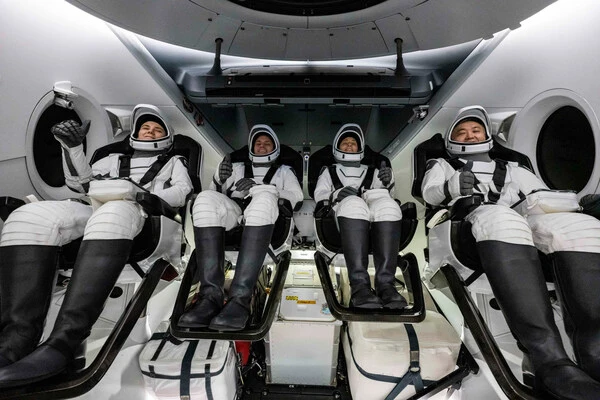After 157 days in orbit, NASA’s SpaceX Crew-5 mission to the International Space Station (ISS) has come to an end. The international crew of four, consisting of NASA astronauts Nicole Mann and Josh Cassada, JAXA astronaut Koichi Wakata, and Roscosmos cosmonaut Anna Kikina, splashed down safely in their Dragon spacecraft off the coast of Tampa, Florida, on Saturday. The spacecraft was retrieved by teams aboard SpaceX recovery vessels.
The Crew-5 mission, which lifted off on a Falcon 9 rocket from NASA’s Kennedy Space Center in Florida on October 5, 2022, marked the agency’s fifth commercial crew rotation mission to the ISS. The crew traveled 66,577,531 miles during their mission, spent 156.5 days aboard the space station, and completed 2512 orbits around Earth.
During their time on the ISS, the crew performed a wide range of scientific experiments, maintenance activities, and technology demonstrations. Cassada and NASA astronaut Frank Rubio conducted three spacewalks, preparing the station for and installing two new International Space Station Roll-Out Solar Arrays (iROSAs). Mann and Wakata teamed up for two spacewalks, outfitting the orbiting laboratory for solar array augmentation.
In addition, the crew tested hydroponic and aeroponic techniques to grow plants without soil, released Uganda and Zimbabwe’s first satellites, studied how liquids move in containers in simulated lunar gravity to generate data to improve Moon rover designs, and tested an on-demand system to produce specific quantities of key nutrients from yogurt, kefir, and a yeast-based beverage. The crew also grew dwarf tomatoes in efforts to address the need for a continuous fresh-food production capability in space and reinstalled the station’s bioprinting facility as a stepping stone in long-term plans to manufacture whole human organs in space.
“Welcome home, Crew-5!” said NASA Administrator Bill Nelson. “Each advancement these explorers make is not an achievement for one, but a giant leap for all of humanity.”
The Crew-5 flight is part of NASA’s Commercial Crew Program, which aims to provide safe, reliable, and cost-effective transportation to and from the ISS and low-Earth orbit. This program has already increased the opportunity for discovery aboard humanity’s microgravity testbed for exploration, including helping NASA prepare for human exploration of the Moon and Mars.
Endurance, the Dragon spacecraft used in the Crew-5 mission, will return to Florida for inspection and processing at SpaceX’s Dragon Lair. Teams will inspect the spacecraft, analyze data on its performance, and process it for its next flight.
The Crew-5 mission follows the launch of NASA’s SpaceX Crew-6, which docked to the ISS on March 3, beginning another science expedition.
The Commercial Crew Program: A New Era of Spaceflight
The Commercial Crew Program is a public-private partnership between NASA and two American aerospace companies, SpaceX and Boeing. This program aims to develop and operate safe and reliable spacecraft for the transportation of crew and cargo to the ISS and low-Earth orbit.
The Crew-5 flight is part of this program and follows the successful launch and docking of SpaceX’s Crew-6 mission. This collaboration between NASA and private companies has resulted in significant progress in space exploration and research, opening up new avenues for scientific discovery.
The Role of the Commercial Crew Program in Space Exploration
NASA’s Commercial Crew Program is a crucial component of the agency’s broader goals of advancing space exploration and preparing for human missions to the Moon and Mars. The program’s focus on safe, reliable, and cost-effective transportation is essential in enabling more research and discovery in microgravity conditions.
The Commercial Crew Program has already enabled additional research time and has increased the opportunity for discovery aboard humanity’s microgravity testbed. This includes the development of new technologies, the study of human physiology in space, and the exploration of the effects of long-duration spaceflight.
The success of the program also represents a significant milestone in fostering partnerships between NASA and commercial space companies. These partnerships enable more access to space, provide new opportunities for research and exploration, and contribute to the development of a sustainable and robust space economy.
The Future of the Commercial Crew Program
The Commercial Crew Program has already provided significant benefits to NASA and the scientific community. The program has enabled more frequent and cost-effective access to the ISS, allowing for longer research missions and the opportunity for new discoveries.
The Crew-5 flight is part of NASA’s Commercial Crew Program and its return to Earth follows on the heels of NASA’s SpaceX Crew-6 launch, which docked at the station on March 3, beginning another science expedition. As the program continues, it will play a critical role in preparing for future human missions to the Moon and Mars.
The Crew-6 mission will focus on a wide range of scientific research, including the study of plant growth in space, the development of new materials, and the exploration of the effects of spaceflight on the human body. The mission will also continue the ongoing maintenance and upgrades of the space station’s systems and equipment.
NASA has already announced plans for the Artemis program, which aims to land the first woman and the next man on the Moon by 2024. The Commercial Crew Program will play a vital role in transporting astronauts to and from the lunar surface, paving the way for the establishment of a sustainable lunar presence.


